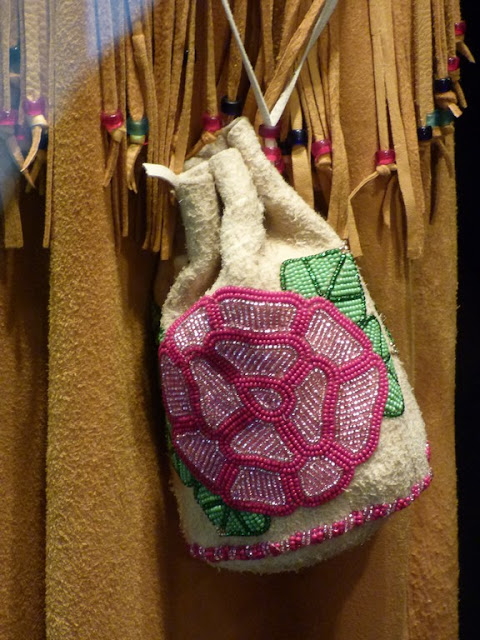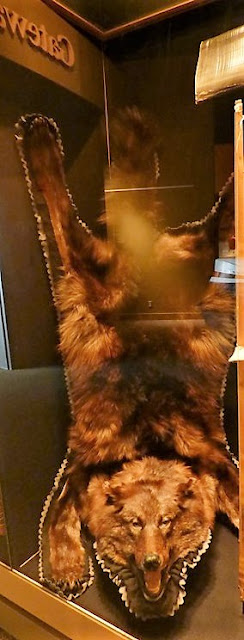Day 9, Sep 7, 2018: FAIRBANKS
SUMMARY:
Pioneer park, Morris Thompson cultural
and visitor center, Antique car museum Fountainhead, Georgeson
Botanical center at the University of Alaska, Wedgewood wild life
sanctuary
Reached Fairbanks by 9.30. Parks
highway was ordinary compared to the scenic highways we had driven
earlier.
is the map from Talkeetna to Denali to
Fairbanks
ACCOMMODATION:
Golden North Motel, Fairbanks
Clean, quiet, spacious rooms.
Conveniently located 2 miles from the airport and top
tourist attractions such as Pioneer Park.


Nicest owners. LOVED THEIR WARMTH!
During checkin they gave pamphlets/info.
Breakfast was available from 6.30 the
next day. When we told them we are driving to Valdez, they very
solicitously ensured we had the magazine with relevant info.
We had an early check in, had some food
and then started on our sight seeing.
Pioneer Park:
Pioneer Park was the first on our agenda. It is an open air museum with original cabins from Old Fairbanks and has the riverboat Nenana there as well.
Includes a mock gold-rush town with authentic pioneer log cabins, mining equipment, museums, a replicated Native American village and a huge, drydocked sternwheeler open for tours. Shops are in old 1900's log cabins moved to this location from town.
Pioneer Park was built in 1967 as
a celebration of the 100th year anniversary of Alaska’s
purchase from Russia. The Park opened on May 27, 1967 for the Alaska
‘67 Centennial Exposition. At that time, the park was known as
Alaska 67 or A 67 for short. A few months after the park opened,
its name was changed to Alaskaland. In 2001, the park
was renamed Pioneer Park to reflect the historical nature
of the park.
The Park is bordered on the north by
the Chena River. The name is of Athabascan origin, and is derived
from “che” meaning stick and “na” meaning river—The Stick
River.
In 1901, Fairbanks’ founding father, E.T. Barnette traveled
up the Chena in search of the town of Tanana Crossing, now called
Tanacross, where he had hoped to establish a trading post.
Unfortunately for Barnette, his boat hit a
sandbar, and he was forced to spend the winter along the banks of the
Chena River.
The following spring, a miner by the name of Felix Pedro
found gold in the surrounding hills. Barnette decided to establish
his trading post right where he was. That early community was known
as Barnette’s Cache, but within a year it became known as Fairbanks
after Senator Charles Fairbanks of Indiana, who eventually became
Vice President under Theodore Roosevelt during Roosevelt’s second
term.
Mining Valley:
In the Mining Valley, we saw some of
the equipment used in the early mining operations. Son found the old machines with gears AWESOME!
The large water spout is called a monitor or a giant. It was used to wash large amounts of soil and rock from the hillside to make it easier for prospectors to remove gold.
The large water spout is called a monitor or a giant. It was used to wash large amounts of soil and rock from the hillside to make it easier for prospectors to remove gold.
Steam shovels, like those in the Valley,
helped to reduce some of the backbreaking labor of those early days.
Pioneer Park’s steam shovel was also used on the Panama Canal and
in Hawaii before it was brought to Alaska during the Gold Rush.
Gold was discovered in Fairbanks in
1902 by Felix Pedro. Those who missed their chance in Dawson
stampeded into the Tanana Valley to mine. The first year wasn’t
very successful and many of the miners quit and left.
The miners didn’t realize that gold
lay 100 feet or more under the permafrost. Once discovered, output
increased, and by 1913 $66 million dollars in gold was mined.
Around
1910, gold mining began declining, not because of the lack of gold,
but because of a decline in trees that were used as fuel to thaw the
ground and provide the necessary water pressure for sluicing.
The
mining technique included clearing the land of brush and trees in the
fall, digging shafts in the winter, using fires to thaw the ground
and the dirt would be hauled to the surface, and repeating the
process. Then, in the spring, they would use a sluice box with slats
to catch the gold while water washed away the silt and gravel. (Gold
is heavier than both silt and gravel.)
Most of the buildings don’t open
until noon. So we drove on to Morris Thompson cultural and
visitor center
Morris Thompson cultural and visitor center:
Open year round. FREE. It's a lovely place!
Plane in the ceiling
Plane in the ceiling
A BOAT above the window
Lots of native items

Bead work
In the Elder’s hall where we learn about Athabascan culture and view historic and contemporary art and tools.
Whale skull and tusks

Snow shoes, birch baskets, leather clothing adorned with bead work
IVORY AND WHALE BONE
Three life-sized dioramas depict
the seasons.
Summer features a fish camp and a stunning view of Nuchalawoyya—the place where the Yukon and Tanana rivers meet.
In fall, a grizzly digs for ground
squirrels, and a hunting camp shows the connection we have with the
land.


We view the winter diorama from inside the warmth of a public use cabin. Outside, northern lights dance across the sky, while a moose peers through the window.

Next we drove to Wedgewood Drive. Saw
the resort.
cabbage patch
Parked the car there itself and followed the red flags to the Antique Auto Museum. Could have driven as well as we later discovered.
Wedgewood resort:
Very pretty flowers, cabbage patch and prelude to car museum...cabbage patch
Parked the car there itself and followed the red flags to the Antique Auto Museum. Could have driven as well as we later discovered.
Fountainhead Antique Auto Museum [$10]
Summer Hours: Sun - Thurs 10am to 8pm;
Fri & Sat 11am to 6pm
Over 80 American made antique cars. WOW, WOW WOW. We
were so fascinated and spent some 3 hours in the museum!!
On the grounds of Wedgewood Resort, the museum showcases
dozens of historically significant, pre-World War II automobiles.
The museum houses some amazing
classics. Its rotating collection of more than 80 autos includes an
1898 Hay Hotchkiss, a tulip shape 1903 Cadillac, the last remaining
1920 Argonne and a 1917 Owen-Magnetic with an electric motor. The
museum even has on loan the 1905 Sheldon Runabout that was the very
first car ever built in Alaska.
The museum displays large format
historic photos and videos to bring to life the emerging Alaska of
the early 20th century. There are pictures of Alaskans customizing
their cars to navigate through the snow, ride on rails or even cut
firewood. We also see examples of “alternative” vehicles from way
back when, such as early steam, electric and hybrid cars, as well as
the first American Midget racers and the first V16-powered engine.

The museum also features a Vintage Clothing section, which explores the ways that fashions have changed over the course of eight decades, as well as how the rising popularity of automobiles had an impact on fashion. The collection includes more than 130 dresses, suits, shoes, coats and accessories spanning eight decades.
We can participate too. In the exhibit about the historic Valdez-Fairbanks Trail—Alaska’s first major transportation artery, which is now the Richardson Highway—put on a duster, hat and gloves and take a picture in front of a replica of the original Sourdough Roadhouse, or climb inside a 1911 Everitt and pose with a grizzly bear hide.
All of the museum’s automobiles are
still quite operable, so on summer evenings a driver takes a car out
for a roaring spin around the grounds.
THERE IS EVEN A SLED
THERE IS EVEN A SLED
We had to reluctantly leave the museum,
walk back to our car. Then we drove to the same place, parked at the
entrance of the Fountainhead Wedgewood Wildlife Sanctuary
Fountainhead Wedgewood Wildlife Sanctuary
free, open 24/7
15 different kinds of mammals—from
beavers to red foxes, flying squirrels, snowshoe hares, and even
moose—and several species of birds. Throughout the Sanctuary’s
trail system there are 14 interpretive signs, how the birds, fish,
frogs, and mammals survive in interior Alaska’s tough climate
The .7-mile Taiga Trail winds through boreal forest habitats, including tall white spruce, paper birch, black spruce and aspen. The trail also traces the western shore of Wander Lake, featuring a great spot for views on a large observation deck.
The 2-mile Wander Lake Trail, which loops around the lake, features a beaver hut, water meadow, photography blinds and shallows that attract wading birds, as well as providing a rearing habitat for non-game fish.
birder’s gold mine. Pick up the
checklist of more than 100 bird species commonly seen here (including
a bevy of owls, thrushes, cranes, pipits, kingfishers) and possibly
even some migrating birds, such as a tundra swan or Eurasian Wigeon.
The sanctuary connects to Creamer’s Field Migratory Waterfowl
Refuge nature trails; the Wedgewood Resort is also home to the Alaska
Bird Observatory.
Plenty of benches to sit down with
binoculars, camera or sketchbook.
We went for the short trail, reached
the Wander lake, took some pics and left. It was already past 6 pm.
Public art...
Georgeson Botanical Garden:
We drove to the Georgeson Botanical
Garden Milepoint 359, Parks Hwy Fairbanks.
The gardens are on the campus of the
University of Fairbanks. Perched on a slope below the university, the
garden is a northern oasis of flowers, trees, shrubs, herbs, and
whimsical features. if our garden had non-stop sunlight
during the growing season we can see what’s possible. This
peaceful sanctuary boasts an impressive collection of some of
Alaska's 3,000 varieties of flowers, vegetables, and herbs.
Cabbages here...
Cabbages here...
We regretfully wound up for the day...
we had missed out on LARS, Large Animal Research Station , the UA
Museum of the North etc.
We were very happy with the flavor of Fairbanks we had managed to savor in our short stay.
Our report continues here:
Our report continues here:
VIDEO LINKS:
Palmer and Fairbanks (Hatcher pass,
independence mine, Alaska state fair, Pioneer park, Morris Thompson
cultural and visitor center, Georgeson Botanical garden, Wedgewood
Wildlife Sanctuary)
Antique car museum














































































































































































No comments:
Post a Comment